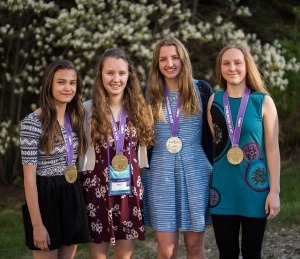
Outstanding Results at the Canada-Wide Science Fair

Team HWDSB at the Canada-Wide Science Fair: Camila Moran-Hidalgo, Isabella O’Brien, Margaret Williams and Zoe Chisholm.
They are trying to save water fleas to protect lake biodiversity, using silver nanoparticles to create antimicrobial bandages and finding fabrics less likely to transmit hospital-acquired diseases.
And May 14-21, they also brought home medals from the Canada-Wide Science Fair in Montreal.
Four HWDSB students were among those representing our region at the national fair that drew 500 of the best young scientists from across Canada. The Bay Area Science and Engineering Fair (BASEF) funded the trip for local students.
BASEF’s Canada-Wide Science Fair (CWSF) competitors brought home 15 awards, enough land BASEF a tie with Calgary for the most medal-winning projects in the country. Congratulations to all competitors.
Here are the outstanding HWDSB students and their projects.
Isabella O’Brien, Grade 9, Westmount Secondary School, Hamilton
Project – Aquatic Osteoporosis: Remediating the emerging problem of lake calcium decline
Lake calcium decline is an emerging environmental problem affecting soft water shield lakes in Canada, North Eastern United States and Scandinavia. Calcium sensitive Daphnia pulex (water fleas), a key component of many aquatic food webs, are at risk. This project investigates the possibility of remediating this problem by adding pulverized recycled shells to calcium-deficient lakes to help maintain Daphnia pulex populations, thus protecting lake biodiversity.
Awards:
- Challenge Award (Intermediate), Environment
- Excellence Award (Intermediate), Gold Medal
- Western University Scholarship Gold Medallist, $4,000 Entrance Scholarship
Zoe Chisholm & Camila Moran-Hidalgo, Grade 8, Sir William Osler, Dundas
Project – Antimicrobial Wound Dressing from Synthesized Silver Nanoparticles on Cellulose
The aim of this project is to create an antimicrobial powder wound dressing by synthesizing silver nanoparticles onto cellulose. We compared three methods of synthesizing silver nanoparticles onto a cellulose powder: a chemical synthesis method, a plasma treatment method and an autoclave reduction method. It was found that all three methods of synthesis produced spherical nanoparticles and had antimicrobial effects against Streptococcus pneumoniae.
Awards:
- Excellence Award (Junior), Gold Medal
- Western University Scholarship Gold Medallist, $4,000 Entrance Scholarship
Margaret Williams, Grade 11, Ancaster High School
Project – The Role of Fabric in the Prevention of Nosocomial Illness
Studies have shown that environmental surface contamination can play a marked role in the nosocomial (hospital-acquired) transmission of microorganisms such as methicillin-resistant Staphylococcus aureus (MRSA) and E. coli. This experiment tested the viability of these pathogens on different types of fabric to demonstrate which provided the best antimicrobial surface for use in medical settings.
Awards:
- Excellence Award (Senior), Silver Medal
- Dalhousie University Faculty of Science Entrance Scholarship; Senior Silver Medallist, $2,500
- UBC Science Entrance Award; Senior Silver Medallist, $2,000
- University of Ottawa Entrance Scholarship, Senior Silver Medallist, $2,000
- Western University Scholarship, Silver Medallist, $2,000 Entrance Scholarship
Updated on Tuesday, May 24, 2016.

